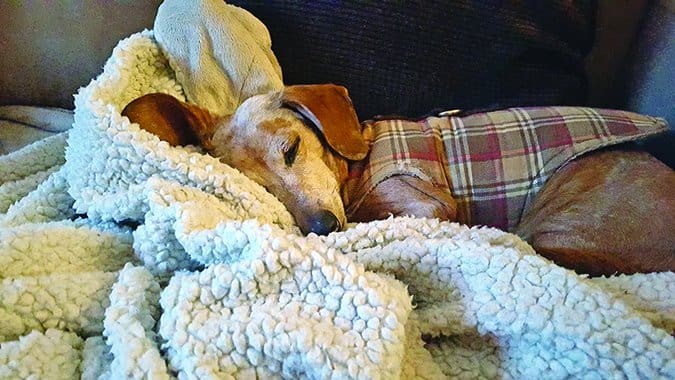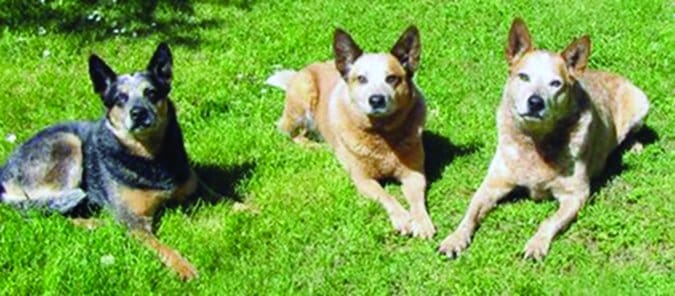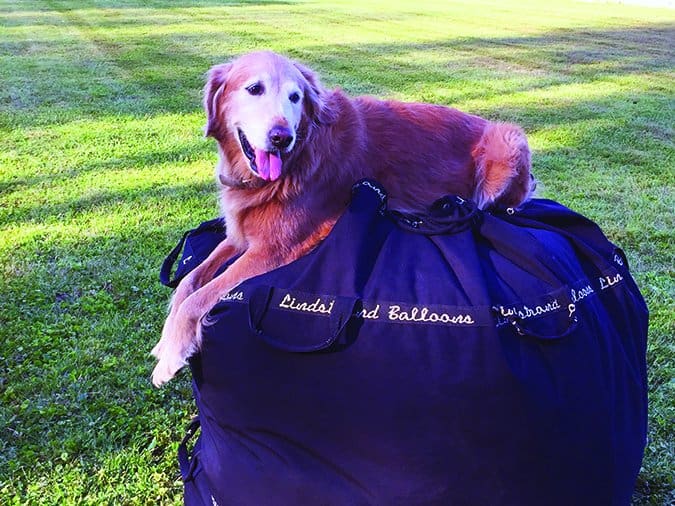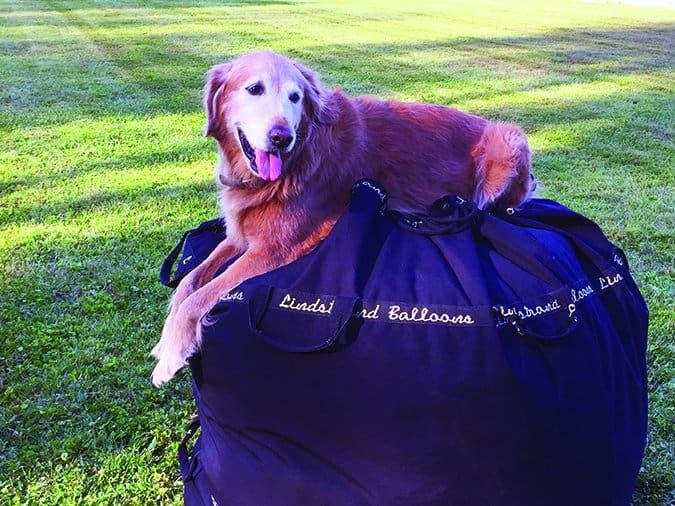In the June 2016 issue, I shared descriptions of some unique and useful behaviors that some of my trainer friends had taught their dogs – mostly by noticing, capturing, and reinforcing behaviors that their dogs had started doing on their own. They had taught their dogs to do things such as guiding them to hidden poop in the yard (at pick-up time), to drop “inside toys” inside the threshold (before going outdoors) and drop dirty “outside toys” outside the door (before going in the house), to come and sit to “take a pill” at medication time, and to stand in a certain spot and pose to have the dog’s hind end cleaned (for a dog with chronic diarrhea). At the conclusion of that article, I challenged our readers to share some of the neat, cute, or helpful behaviors and cues they had taught their dogs – or that, more precisely, their dogs had learned on their own through association!
I have to say, I didn’t expect many. As a prize for one randomly selected response, I offered something small – a copy of one of my training books. I certainly didn’t expect hundreds of submissions, but that’s exactly what we received! Wow! Thank you! And great job to all of you amateur and professional dog trainers! Developing these skills in our dogs takes – first and foremost – an owner who is interacting with her dog and paying attention to what the dog “says” in the conversation. That’s the very foundation of a good relationship between two individuals of any species!
The following are some of my favorite submissions from among the hundreds that WDJ subscribers sent in – including one selected at random to win one of my books! We had to make a random selection; there were too many great submissions to choose “the best” one!
“Take a Break”, “Car”, “Not Optional”
I loved the article on “Unconventional or Unintentional Cues” in the June issue. I especially liked the idea of teaching dogs to “find the poop” – brilliant!
I talk to my dogs all the time, explaining what we are doing, naming objects, actions, places, etc. Dogs can learn so much and I think it enriches their lives to keep learning new things. I have used various unconventional cues over the years. Here are a few of them:
One cue was for a ball-crazy Boston Terrier who is no longer with us. Peaches loved playing with her basketball so much that I had to teach her to “take a break” so she didn’t become exhausted and overheated. At first I had to take the ball away and put it out of reach, giving it back once she had rested and cooled down. Eventually all I had to do was say, “Take a break!” and she would stop, look longingly at the ball, then come in for a rest, knowing the ball would be there when she went out to play again later.
I walk my Sheltie-mix on a country road that is generally quiet, with little traffic. It is narrow, curvy, and has only a very narrow shoulder between pavement and ditch. For much of the walk I let Sasha range on a long leash ahead of me, sniffing as we go. She now knows when I say, “Car!” to move over into the ditch and wait for the car to pass. Often she will move over as soon as she hears a vehicle coming before I even have a chance to give the cue.
Sasha likes to lie out on the back deck. Often, when I open the door and say, “Come on in!” she will duck her head and look hopeful that maybe I will let her stay out awhile longer. If I am not in a hurry for her to come in I will say, “Okay, you can stay out,” and she relaxes. But if I say, “Not optional!” she knows that she has to come in.
– Pam Kutscher, Falmouth, KY

“Snooze Button”
Here is one of the accidental but useful cues I’ve taught my 13-year-old miniature Dachshund. Chile has an internal alarm clock that she generously uses to tell me when it’s time to get up (and feed her). But every good alarm clock also needs a snooze button!
Chile sleeps in her own orthopedic bed on the floor by our bed. Every morning she comes to my side of the bed; for some reason, she thinks my husband deserves to sleep in more than I do! She puts her paws up and whines until I lean over and pet her. Since I’m often not ready to get out of bed yet, I started petting her and then saying, “I want to snooze!” I didn’t want to use “back to bed,” because that is a trained cue I use at other times, and she often gets a food reward for that behavior. She quickly figured out that after I said “snooze” she would get no further attention until I got out of bed, so she would go curl up in her blanket. This bought me an extra 10 to 20 minutes of time before I had to get out of bed.
Now that she understands that “snooze” means she’s done her job by waking me up, she goes back to her bed and takes a little nap until I’m ready to get the day started and, of course, feed her!
– Tina Flores, KPA-CTP, CSAT, Doggy Einsteins Training, San Diego, CA
The Mail Carrier
My German Shepherd, Eli, started to grab at the mail when I went to the mailbox, so I would hand him a piece of junk mail to carry. At first he would want to rip it up, so I would take it away and he did not get a reward. When he carried it in the house without ripping it, he got jackpot rewards.
He also started to want to carry deliveries from UPS. If he can fit it in his mouth, he can carry it: boxes, grocery bags, mail, etc. When he does a good job, he gets his jackpot reward.
For Eli, this is all self-taught; I just captured it and rewarded it. Plastic grocery bags are still a challenge since his teeth punch holes and then the bags tear, so I don’t let him carry bags with anything soft or fragile. But I always know when the mail or UPS guy comes!
– Jill Pinder
The “Friends” Dancer
The article made me think of my much-loved yellow Labrador, Sonny, now departed for many years. He was a young dog when the television series “Friends” was popular, and we were regular viewers. Every Thursday, at 8 p.m., we were in front of the television (prior to the DVR days!). When the peppy theme song came on, Sonny and I would jump up from the couch and dance around the living room. It didn’t take too long before Sonny recognized the theme song himself, and he would jump up and give me that “Are we going to dance?” look.
As he got older, and the series went into reruns, we watched the reruns, and he always looked at me with that sparkle in his eye when the theme song came on, even if we didn’t dance so much because of his arthritis. Makes me happy and sad at the same time now. Sonny passed many years ago, but whenever I hear that theme song now, it still brings the sweet memory and a smile to my face.
– Rhonda Klick

“Can’t Reach It”
My Lab-mix loves to play fetch. She’s so great at chasing a tennis ball anywhere. She will always come running back with it and kind of toss it back at me to throw again.
If we’re playing in the backyard and I’m sitting down and she tosses it out of reach, instead of getting up from my chair and getting the ball I simply say, “Can’t reach it.” She has learned that means I can’t reach the ball to throw it to her again. When I say, “Can’t reach it,” she will go and get the ball and drop it right at my feet so that I can reach it and throw it for her again.
When people see us do this, they all think it’s the craziest, coolest thing! I didn’t actually train her to do it, but, boy does it come in handy!
– Debbi Merrill and Gumbo, Bartlett, IL
The Sock Remover
Apache, my soon-to-be 13-year-old Sheltie, takes my socks off for me at night. When he was younger he liked to chew on socks. So I simply held my foot out for him to pull the sock off before he could chew it. Then I would have to “buy” the sock back with treats. Otherwise he would keep and chew on it. In all the years that he’s been doing this, he’s never hurt my foot or toes at all. Sometimes if the sock is a little damp he has to work at getting it off, but he is very gentle doing it.
I’m trying to get him to teach my 14-month-old puppy, Scout, how to take the socks off, but Scout isn’t sure he wants to take over as the official “sock remover.”
– Ruth Ann Furze, Kansas City, MO
“Behind”, “Spin”
Like some other readers, I inadvertently taught my Papillon boy, Remy, “Inside/Outside” going to and from our backyard for potty breaks. Last week Remy shot past me out the front door straight for the street. His recall (which is “Here!”) isn’t rock-solid yet, so I faked a cheerful “Inside!” Fortunately, this turned him around and got him back indoors safe and sound.
While learning his “Inside/Outside” cues, Remy learned “Behind,” too. That’s what I say when he looks behind him and finds the treats I’ve tossed that fall short instead of out in front of him.
Remy will also “Spin” on cue, which is not only cute but useful for drying his feet on the patio rug coming in from a rainy bathroom break. Spinning is one of Remy’s natural expressions of exuberance, so I didn’t have to wait long to capture this behavior and put a cue on it!
– Anu Roots, Dog mom to Remy
“Can’t Reach It” #2
My dog, Phoenix, always drops his ball at our feet for us to pick up to throw for him to play fetch. After a back injury, I was unable to bend over to pick up the ball. I would say, “Sorry Buddy, but I can’t reach it.” He eventually realized that if he would pick it up and put it in my hand, then I would throw it.
Even though my back has long since been better, I continue to say “I can’t reach it!” (just because I’m too lazy to bend over to pick it up). He will then pick the ball up from the ground at my feet, and place it into my hand.
– Sarah
“Put Her in Her Kennel, Please”
I don’t know if it was inadvertent conditioning or just that she had a sublime command of English, but my girl, Boo, learned the phrase “Put her in her kennel, please.” If I asked my husband to do that, she would quietly get off the sofa and go stand in her kennel until my husband came to close the crate door.
Since this was not something she ever got reinforced for doing in conjunction with that phrase, I’m not sure why she was willing to go, but she was!
– Always Training
“Go Get Sadie”
Sadie is my older Cocker Spaniel; based on the shelter’s guess, she’s 16 years old, plus or minus two years, and her eyesight and hearing are failing. Her best buddy is my Ozzie, an 8-year-old Spaniel-mix. When Sadie is laying down resting or circling around at the park to make sure where we are (I’m never far away), I tell Ozzie to “Go get Sadie.” He runs to where she is and punts her in the muzzle and they both come back to me for a treat.
This is really handy, especially when we need to leave and she’s snoozing on the lawn or getting distracted on which way to go. The other people at the park enjoy it, too.
Ozzie will also “Go get Sadie” at home from her hide-away resting spots when it’s time for a meal, go in the car, or just to find her. Oz really takes care of his older “little” sister.
– Sharon
Doorbell Dodging and Closet Treats
We greatly enjoyed the June article about inadvertently teaching your dog something useful. Here is our story, with one unintentional behavior taught, and one unconventional solution to nip a problem in the bud.
The behavior that we unintentionally taught our dog, Leah, was to go out to the back porch when the (front) doorbell rings. Our last two dogs (one of whom is 11-year-old Leah) always exhibited high arousal when our front doorbell was rung, with loud barking and charging around the house. Since usually the doorbell represented the arrival of an uninvited stranger or someone coming to perform work, the dogs were not allowed to go to the door; instead, we would first shoo them out to the back porch.
After our older dog passed away, we started to try desensitizing Leah to the doorbell sound and training her to remain in place for rewards when the bell was rung. That training got sidetracked by some other events, including health problems. Fast forward to a few months ago when the front doorbell rang, and Leah started barking as usual but went straight for the back porch door. At that point I realized that we had actually trained her to think, “That sounds means I should go out on the porch and mind my own business; I don’t need to be involved with the activity out front.”
This is a better solution for Leah behaviorally, since she is not good at greeting people and is wary of strangers. I plan to try to reinforce the response by having treats near the back porch door so I can throw some out there as she goes out. She’s highly food-motivated so this would be meaningful to her.
Which leads us to our next trick! The unconventional behavior we taught her was to expect treats from the bedroom closet. Leah sleeps in our bedroom in a small ex-pen. The master bedroom has a closet with sliding doors on wheeled tracks. A month or so ago, she reacted fearfully to the rumbling sound of the closet door opening after she had been confined in her pen for the night. She is sound sensitive and afraid of thunder, gunfire, etc., but this sound had never appeared to bother her before. We had to come up with a solution to reverse this.
We started with treats dropped on the floor near the closet, then inside it; at first, she was a bit hesitant about retrieving them – but not scared enough to shy away. We stored a small container of treats in the closet, and made sure she saw that the treats came from this container and that it was put away there after she had a few. Then we started giving her a treat any time she was within earshot of the closet and we opened the door, to associate the sound with a treat.
Almost needless to say, she now comes to the closet for a treat when she hears the door open. If the door is already open and she shows up in the bedroom, she goes to the closet to see if there are treats on the floor. No more scary closet; now it’s a pantry!
– Marlys Ray

Our Winner: “Beat Up the Bed”, “Wanna Greenie?”
I had to laugh when I saw the title “Fun and Useful Unconventional Cues and Behaviors.” Our Shepherd-mix, Captain Awesome, picked up two that are quite interesting.
First was something that we called “beating up the bed.” Whenever Captain was excited about something, he’d go into bow position and beat up whatever was underneath him – he’d dig and scratch and scrunch up a bed, rug, or blanket. Unintentionally, we said every time, “Captain, you’re beating up the bed!” One day, I said, “Hey, Captain, beat up the bed!” – and he did!
The second one was “Wanna Greenie?” When Captain Awesome was a puppy, he loved Greenies. We’d always ask if he wanted one. We kept the wrapped ones in a basket, and whenever we said, “Wanna Greenie?” we’d go grab one from the basket. One day, I asked Captain, “Wanna Greenie?” and he went to the basket, grabbed one himself, and brought it to me. What a good boy!
– Jennifer O’Neil Cote
“Off Limits to You!”
Buddy, my Golden/Lab/Collie-mix, wouldn’t stop digging up my flower bed around the corner of the house. While I sat on the patio, reading my Whole Dog Journal, Buddy would dig up the soil. Every time I removed Buddy from the flower bed, I would tell him, “Off limits to you!” and take him away from the area to a grassy spot that he likes.
One day, too lazy to get up, I simply called his name and said, “That is off limits to you.” He looked at me for a moment and then walked away to the grassy spot. Curious, I started using “off limits” when I didn’t want him somewhere. Now he turns around and goes to a spot that knows is “on limits” for him. Truly, one of the easiest commands he has mastered, probably because he doesn’t associate it with anything from obedience classes!
– Karen Wentzel
“Call Spur!”
As a 10-year-old with no knowledge of learning theory, I inadvertently taught my dog to go find another family member. Growing up, we had a 55-acre weekend farm. Our German Shepard, Spur, always went with us. Our family was often scattered in various locations around the farm. There were occasions when Spur would follow me down to the boat dock, but I would not want her to get caught in fishing lures and hooks, so I would shout out to my parents to call Spur. They would call her and she would go to them.
It didn’t take her long to figure out that “Call Spur!” was the cue to go to the distant family member, without them ever calling her. This became a useful behavior in the pre-cell phone world!
Spur became a great courier. For example, Mom would place a note on Spur’s collar and then give the cue “Call Spur.” She would come running to find me with a note that would say something like, “Dinner will be served at 6 p.m.”
– Jen
“Who’s Got Muddy Paws?”
When I walk my four dogs in inclement weather, only one of them has sufficiently furry paws that she requires rinsing off in my walk-in shower. One morning after such a walk, I removed the harness from my Golden Retriever-mix, Mandy, at the door. I asked playfully what I must have absentmindedly said many times before: “Who’s got muddy paws?” I finished removing harnesses from the other dogs and wiping their paws with a towel.
When I looked up, Mandy had disappeared. I walked down the hall and into the bedroom, where I saw a trail of muddy paw prints on the carpet going back and forth from the shower. Since I had delayed, Mandy had gone into and out of the wet shower multiple times before I arrived! Now I know whenever she hears “muddy paws,” she’s headed for the shower (and I get there faster!).
– Marty Metzler

“It’s Time to Do Your Job”
I am a balloon pilot and have been for more than 30 years. My husband, Peter, who passed away 12 years ago, was also a balloon pilot and taught me how to fly. We’ve had Golden Retrievers for many years, and a year and a half after my husband died I got a Golden puppy, Sam (Samantha). I took her along whenever I went ballooning – not in the balloon, but in the chase vehicle, where she was well looked after by my incredible crew.
At the end of each flight we pack the balloon envelope back into its bag. The fabric tends to hold air, so after the envelope is in the bag and tied securely, we usually have kids or crew jump on it to get some of the air out. When Sam was almost a year old she started, on her own, jumping up on the bag and sitting there, posing for pictures.
At times I would land in a field or park and Sam would be sniffing around within sight of us, and all I had to do was say, “Sam! It’s time to do your job!” and she would stop whatever she was doing, and, to the surprise and delight of my passengers and spectators, she would run and jump on the bag, patiently waiting until we were ready to load it back into the chase vehicle. During this waiting period, there were many pictures taken of her – alone, and with the crew, passengers, and spectators.
Unfortunately, Sam passed away in early March of this year ,after a short bout with cancer, just short of her 10th birthday. She was very social and petted by thousands of people.
– Susan Stamats
“It’s the TV”, “They’re Our Friends!”
What a fun subject! I have two examples. The first one was taught by, of all people, my hubby, who is not a trainer by any means. Our German Shepherd, Gus, would bark when he heard a doorbell or dog barking on TV. My hubby would just say, “It’s the TV!” in a normal, conversational tone, and to my surprise – no treats involved! – Gus quickly learned to ignore everything on TV. After his initial, brief bark, when he heard “It’s the TV!” he would shush, though he still had that look in his eyes like, “I am not sure if I believe you!”
Our current German Shepherd, Danja, has a strong prey drive and used to bark at the sight of deer in our yard. Whenever she saw a deer, she’d bark, and I would go to her, pet her, and say, “They’re our friends!” Again, there were no treats involved, as these situations came up so unexpectedly. Now, when she sees a deer, Danja still might bark very briefly, but then she will look at us and we say, “They’re our friends!” Then she’ll be quiet while we watch them together.
I’m impressed how dogs can learn so quickly with these casual methods. And even more impressed with my husband teaching Gus to be quiet at the TV sounds. It is the only training I have ever seen him do in all the 35 years I have known him!
– Irma Kapsenberg, GOOD DOG! Gentle Training, Corvallis, OR
Thanks, WDJ Readers!
All we can say after reading all of these (and hundred more!) submissions is: Training rocks, whether it’s on purpose or accidental! Thanks to everyone who submitted an account of their dogs’ behaviors and cues, and keep up the great work!






